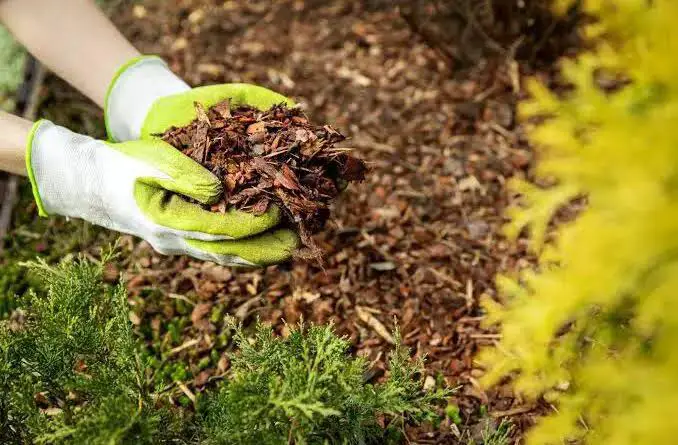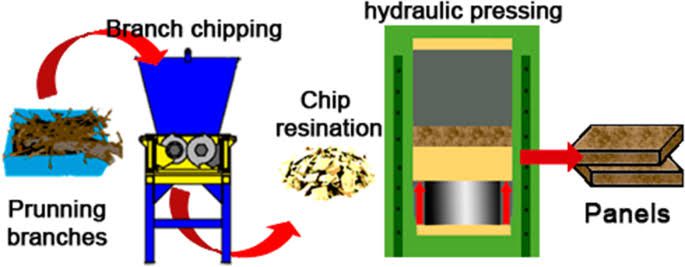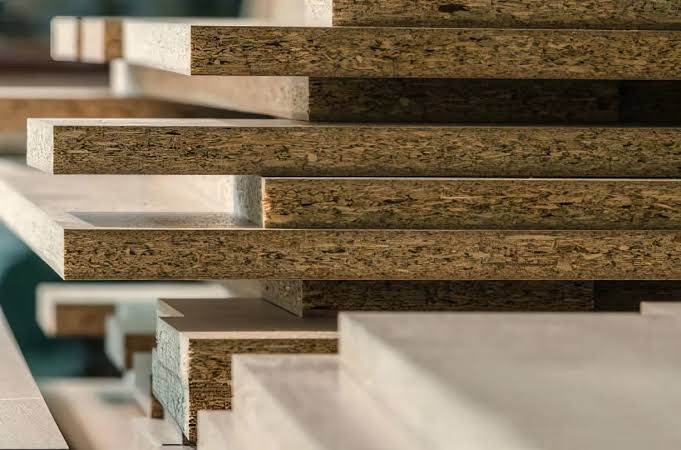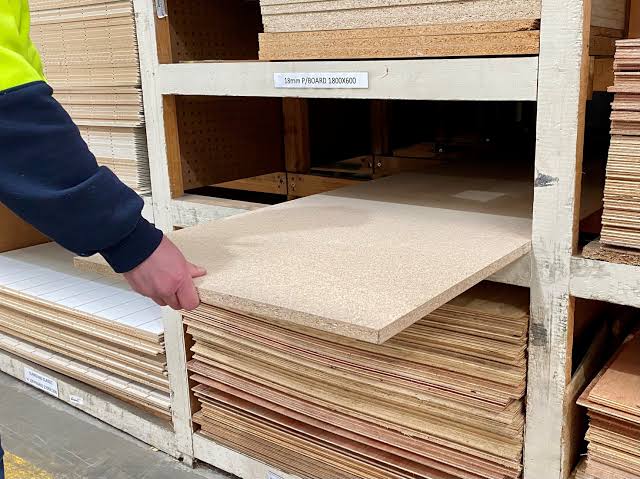Converting wood wastes into particleboard in a cool and wonderful idea, instead of letting these wood wastes go to waste, we can turn them into something useful called particleboard. Particleboard is a type of engineered wood product made from wood particles, such as wood chips, sawdust, and shavings, mixed with a resin or adhesive and pressed together under heat and pressure.
The process of converting wood wastes into particleboard starts with collecting the wood wastes from various sources, such as lumber mills, furniture factories, and construction sites. These wood wastes are then sorted and cleaned to remove any impurities like dirt, nails, or other debris.
Once the wood wastes are clean and sorted, they are mixed with a resin or adhesive, which acts as a binder to hold the wood particles together. The mixture is then spread out onto a flat surface, such as a conveyor belt or a forming table, and pressed together under high pressure.
The pressing process not only compresses the wood particles but also activates the resin or adhesive, causing it to bond the particles together. Heat may also be applied during this process to accelerate the curing of the resin and improve the strength of the particleboard.
After the pressing process is complete, the particleboard is trimmed to size and sanded to achieve a smooth surface finish. It can then be further processed or finished according to its intended use. For example, it can be laminated with a decorative veneer, painted, or coated with a protective finish.
Particleboard made from wood wastes offers several advantages. It helps reduce the amount of wood going to landfills, thereby minimizing environmental impact. It also provides a cost-effective alternative to solid wood, making it suitable for various applications in construction, furniture making, and other industries.
In addition, converting wood wastes into particleboard is an efficient way to utilize wood resources and reduce waste. By repurposing wood wastes into a valuable product like particleboard, we can contribute to sustainability efforts and create economic opportunities in the wood processing industry.
Read Also: Environmental Management Tips for Sustainable Living
Types of Recyclable Wood Wastes and their Uses

There are various types of recyclable wood wastes, each with its unique characteristics and potential uses. Some common types include:
1. Sawdust: Sawdust is fine particles of wood created during sawing, sanding, or milling wood. It can be used as a filler material in particleboard and other composite wood products. Additionally, sawdust can be mixed with compost to enhance soil structure and moisture retention in gardening and landscaping.
2. Wood Chips: Wood chips are small pieces of wood typically produced during wood processing operations such as chipping or shredding. They are commonly used as a biomass fuel for energy generation in biomass boilers or as a mulch material for weed suppression and moisture retention in landscaping.
3. Wood Shavings: Wood shavings are thin curls or strips of wood produced during planing, shaving, or carving wood. They are often used as bedding material for livestock and poultry, as well as for packaging material or as a filler in animal bedding.
4. Wood Offcuts: Wood offcuts are leftover pieces of wood resulting from cutting, shaping, or trimming wood during manufacturing processes. These offcuts can be used in various ways, including as fuel for heating or energy generation, as raw material for crafting and woodworking projects, or as feedstock for producing particleboard and other engineered wood products.
5. Bark: Bark is the outer protective layer of trees and is often removed during wood processing operations. While it is not typically used in woodworking, bark can be utilized as mulch in gardening and landscaping, as fuel for biomass boilers, or as a raw material for producing biochar, a soil amendment used for improving soil fertility and carbon sequestration.
Overall, the various types of recyclable wood wastes offer a range of potential uses, from energy generation and landscaping to manufacturing and agriculture. By repurposing these wood wastes, we can reduce waste, conserve natural resources, and create value-added products.
How to Convert Wood Wastes into Particleboard

Converting wood wastes into particleboard involves several steps:
1. Collection and Sorting: Begin by collecting wood wastes from sources such as lumber mills, furniture factories, and construction sites. Sort the wood wastes to remove any impurities like dirt, nails, or other debris.
2. Preparation of Wood Wastes: Clean the wood wastes to ensure they are free from contaminants. Depending on the size and type of wood wastes, they may need to be further processed, such as chipping, shredding, or grinding, to achieve the desired particle size.
3. Mixing with Resin: Once the wood wastes are prepared, mix them with a resin or adhesive binder. The binder helps hold the wood particles together and provides strength to the finished particleboard. The ratio of wood particles to resin may vary depending on the desired properties of the particleboard.
4. Forming: Spread the mixture of wood particles and resin onto a flat surface, such as a conveyor belt or forming table. Ensure an even distribution of the mixture to achieve uniform thickness and density in the finished particleboard.
5. Pressing: Press the mixture of wood particles and resin together under high pressure. This compresses the particles and activates the resin, causing it to bond the particles together. Heat may also be applied during this process to accelerate the curing of the resin and improve the strength of the particleboard.
6. Cooling and Trimming: After the pressing process is complete, allow the particleboard to cool and cure. Once cooled, trim the edges of the particleboard to achieve the desired dimensions and remove any excess material.
7. Finishing: Sand the surface of the particleboard to achieve a smooth finish. Depending on the intended use, the particleboard may be further processed or finished with decorative veneers, paints, or coatings.
8. Quality Control: Inspect the finished particleboard for defects such as delamination, warping, or surface imperfections. Ensure that the particleboard meets the required standards for strength, durability, and appearance.
The Benefits of Converting Wood Wastes into Particleboard
Converting wood wastes into particleboard offers several benefits:
1. Waste Reduction: By utilizing wood wastes as raw material for particleboard production, we can significantly reduce the amount of wood sent to landfills or burned as waste. This helps mitigate environmental pollution and conserves valuable natural resources.
2. Resource Efficiency: Particleboard production typically requires less wood compared to solid wood products. By efficiently utilizing wood wastes, we maximize resource efficiency and minimize the need for harvesting virgin timber, thereby preserving forests and biodiversity.
3. Cost-Effectiveness: Particleboard made from wood wastes is often more cost-effective than solid wood or other engineered wood products. This affordability makes it an attractive option for construction, furniture making, and other applications where cost considerations are important.
4. Versatility: Particleboard is a versatile building material that can be used in a wide range of applications, including furniture manufacturing, cabinetry, flooring, and interior decoration. By converting wood wastes into particleboard, we create a valuable resource that can be adapted to various needs and specifications.
5. Customization: Particleboard can be manufactured with different densities, thicknesses, and surface finishes to meet specific requirements. This customization allows for greater flexibility in design and construction, enabling the creation of tailored solutions for diverse projects and applications.
6. Environmental Benefits: Particleboard production typically consumes less energy and emits fewer greenhouse gases compared to manufacturing solid wood products. Additionally, using wood wastes as raw material helps sequester carbon and reduce overall carbon footprint, contributing to climate change mitigation efforts.
7. Job Creation: Converting wood wastes into particleboard can create employment opportunities in the wood processing industry, from collection and sorting of wood wastes to manufacturing and distribution of particleboard products. This contributes to local economies and supports sustainable livelihoods.
8. Promotion of Circular Economy: Converting wood wastes into particleboard embodies the principles of a circular economy, where resources are reused, recycled, and repurposed to minimize waste and maximize value.
Read Also: The Art of Waste to Jewelry Business
The Uses and Benefits of Recycled Particleboard

Recycled particleboard has a variety of uses and benefits:
Uses:
1. Furniture Manufacturing: Recycled particleboard is commonly used in furniture manufacturing for items such as cabinets, shelves, desks, and tables. Its versatility and affordability make it a popular choice for both residential and commercial furniture applications.
2. Cabinetry: Particleboard is often used as a substrate for kitchen and bathroom cabinets. Its smooth surface provides an ideal base for laminates or veneers, allowing for customization in color and style to match any décor.
3. Flooring: Recycled particleboard can be used as a subflooring material or as a core layer in engineered wood flooring systems. Its uniform composition and stability make it suitable for supporting various floor coverings such as hardwood, laminate, or vinyl tiles.
4. Wall Panels: Particleboard can be used as an interior wall paneling material in residential and commercial buildings. It provides a smooth surface for painting or wallpapering and can help improve insulation and soundproofing properties.
5. Doors: Recycled particleboard is commonly used as a core material for interior doors. It provides structural stability and can be veneered or painted to match the overall aesthetic of the space.
6. Packaging Material: Particleboard can be used as a packaging material for shipping and transporting goods. Its strength and durability make it suitable for creating crates, pallets, and other protective packaging solutions.
Benefits:
1. Environmental Sustainability: Using recycled particleboard reduces the demand for virgin timber and promotes sustainable forestry practices. It helps divert wood waste from landfills and reduces greenhouse gas emissions associated with waste disposal.
2. Resource Conservation: Recycled particleboard conserves natural resources by utilizing wood waste materials that would otherwise be discarded. This helps preserve forests and ecosystems while minimizing the need for new raw materials.
3. Energy Efficiency: The manufacturing process for recycled particleboard consumes less energy compared to producing solid wood products. Using recycled materials also reduces the energy required for harvesting, transporting, and processing virgin timber.
4. Cost-Effectiveness: Recycled particleboard is often more cost-effective than solid wood products, making it an affordable option for various construction and manufacturing applications. Its lower cost can result in overall savings for consumers and businesses.
5. Versatility: Recycled particleboard can be engineered to meet specific performance requirements, such as strength, durability, and fire resistance. It offers flexibility in design and construction projects while maintaining consistent quality and performance.
Overall, the uses and benefits of recycled particleboard make it a valuable and sustainable material choice for a wide range of applications in construction, furniture manufacturing, and packaging industries.
The Challenges of Converting Wood Wastes into Particleboard and their Solutions
Converting wood wastes into particleboard comes with its own set of challenges, but there are also solutions to overcome them:
Challenges:
1. Contaminants in Wood Wastes: Wood wastes collected from various sources may contain contaminants such as dirt, nails, or other debris, which can affect the quality of the particleboard.
2. Variability in Wood Waste Composition: Wood wastes can vary in size, species, and moisture content, leading to inconsistencies in the properties of the particleboard.
3. Optimizing Resin Formulation: Achieving the right balance of resin or adhesive binder in the particleboard mixture is crucial for proper bonding and strength.
4. Ensuring Uniform Density and Thickness: Maintaining uniform density and thickness throughout the particleboard is essential for structural integrity and performance.
5. Energy Consumption in Manufacturing: The manufacturing process of particleboard requires energy for drying, pressing, and curing, which can contribute to environmental impacts and production costs.
Solutions:
1. Pre-Treatment and Sorting: Implement pre-treatment processes to remove contaminants from wood wastes before they are used in particleboard manufacturing. This can include sorting, cleaning, and screening to ensure only clean and suitable materials are used.
2. Standardized Processing Techniques: Develop standardized processing techniques to handle different types of wood wastes and ensure consistency in particle size, moisture content, and other properties. This can involve implementing quality control measures and using advanced technology for sorting and processing.
3. Formulation Optimization: Conduct research and testing to optimize resin formulations for specific wood waste compositions. This may involve experimenting with different types of resins, additives, and curing methods to achieve desired bonding strength and durability.
4. Uniform Pressing and Conditioning: Invest in equipment and technology to ensure uniform pressing and conditioning of the particleboard during manufacturing. This includes proper temperature and pressure control, as well as adequate moisture conditioning to prevent warping and delamination.
5. Energy Efficiency Measures: Implement energy-efficient practices and technologies in particleboard manufacturing, such as using renewable energy sources, optimizing production processes, and improving equipment efficiency. This can help reduce energy consumption and minimize environmental impacts while lowering production costs.
Frequently Asked Questions (FAQs) About How to Convert Wood Wastes into Particleboard
1. Q: What types of wood wastes can be used to make particleboard?
A: Various types of wood wastes can be used, including sawdust, wood chips, wood shavings, and wood offcuts from manufacturing processes.
2. Q: How is the quality of the particleboard ensured during the conversion process?
A: Quality control measures, such as sorting and cleaning of wood wastes, standardized processing techniques, and testing of resin formulations, help ensure consistent quality and performance of the particleboard.
3. Q: What are the environmental benefits of converting wood wastes into particleboard?
A: Converting wood wastes into particleboard reduces waste going to landfills, minimizes the demand for virgin timber, promotes sustainable forestry practices, and conserves natural resources.
4. Q: Is particleboard made from recycled wood wastes as strong as solid wood products?
A: Particleboard made from recycled wood wastes can be engineered to meet specific performance requirements and is suitable for various applications in construction, furniture making, and other industries.
5. Q: How does the conversion process affect energy consumption and environmental impact?
A: The conversion process requires energy for drying, pressing, and curing, but using recycled wood wastes helps reduce energy consumption and minimize environmental impacts compared to producing solid wood products.
6. Q: Can recycled particleboard be used in outdoor applications?
A: Recycled particleboard is not typically recommended for outdoor applications due to its susceptibility to moisture damage. However, with proper treatment and sealing, it may be suitable for some outdoor uses.
7. Q: Are there any regulations or standards governing the production of particleboard from wood wastes?
A: Yes, various regulations and standards exist to ensure the safety, quality, and environmental sustainability of particleboard production, including emissions limits for formaldehyde and other volatile organic compounds.
8. Q: What are some innovative technologies being used to improve the conversion process?
A: Innovative technologies such as advanced sorting and processing equipment, resin formulation optimization, and energy-efficient manufacturing processes are being employed to enhance the efficiency and sustainability of converting wood wastes into particleboard.
Read Also: Heartworm Disease: Description, Damages Caused, Control and Preventive Measures

